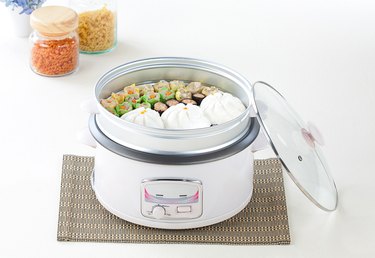
Typical instructions for cooking rice on the stove include covering the rice after it boils. This steams the rice in addition to simmering. However, covering the pan and trapping the steam can also lead to bubbles forming in the starchy water, and these can multiply to the point that they push the pot lid up and boil over, even if the heat is set on low. If you've been unable to prevent this bubbling and boiling over from happening, you've likely resorted to cooking the rice without a lid. This makes the rice, especially the top layer, dry out rather quickly. Keep an eye on the rice to avoid burning it onto the pot's surface.
Step 1
Rinse the rice if necessary -- the manufacturer's instructions will confirm this -- and add water and rice to a pot per those instructions. Different rice varieties require slightly different amounts of water, and adding too little or too much will leave you with rice that isn't fully cooked or that is a mushy mass.
Video of the Day
Step 2
Boil the water and rice without a lid as usual. Once the water boils and you reduce it to low to simmer the rice, leave it for about 5 minutes.
Step 3
Check the water level. Some white rice absorbs water very quickly. Stir to even out areas that are becoming higher and approaching the surface of the water.
Step 4
Stir the rice occasionally and fold the top layer below the rest of the rice as the water level lowers. This helps keep the top layer from drying out.
Step 5
Dig into the rice and check the bottom layer to see how much water remains once you no longer see water above the top of the rice. Stop cooking when you see a little bit of water left at the bottom; the bottom of the pot will look like it has a creamy or starchy layer on it. Do not let all of the moisture evaporate while the heat is on because the rice will absorb the remaining moisture as it cools.
Things You'll Need
Cooking pot
Spoon or fork
Tip
The variety of the rice affects how it reacts to cooking on the stove with or without a lid; you might find you have more success with a particular type of grain length or brand. Success also depends on your personal tastes. Figuring these out is a matter of experimentation; take note of the brand, type, water amount and timing so you know if you should repeat what you did to make a good uncovered pot of rice.
Note that the texture of the cooked rice will be different than what you’re used to with covered cooked rice because it is no longer steamed.
Warning
Don’t leave the rice unattended, especially if it’s white rice. This tends to cook faster than you think it will.
Don’t automatically add more water than the manufacturer’s instructions call for; this usually makes the rice more watery instead of compensating for the increased evaporation rate.
Video of the Day